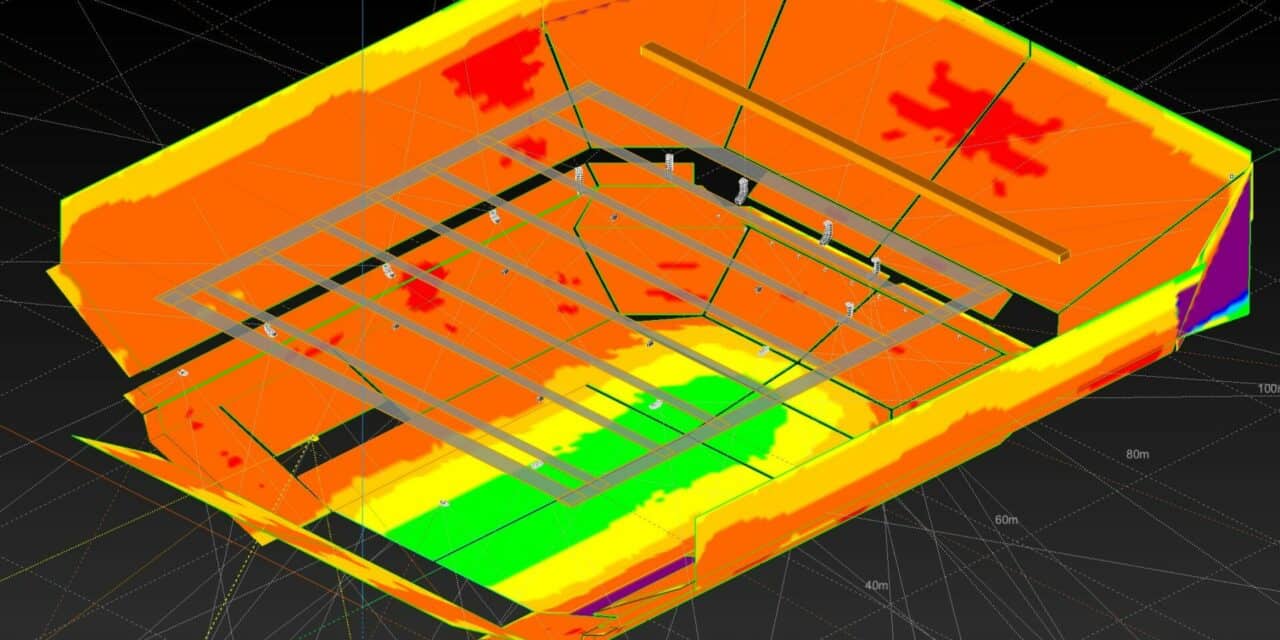d&b audio’s Array calc simulation view showing the system’s performance inside Co-op Live.
Much noise is being made around the acoustics inside Co-op Live. The vision for Co-op Live was to create the best arena for music ever, and that means audio to match.
“It’s great to be working on a project with a defined and clear goal, to be the world’s best live music venue,” said Olly Creedy, associate director at Vanguardia, sound designer at Co-op Live. There were unique challenges and opportunities on the project.
“The main challenges are due to the sheer volume of the space and still maintaining well defined acoustics and clarity,” Creedy said. “It’s far different from a classic music hall or theatre where the early reflections are encouraged. Any useful early reflections are impossible to achieve in a venue this size, where the sound off any of the surrounding surfaces has potential for causing disturbing late reflections. The aim is to provide good aligned direct sound, followed by a smooth dense reverb tail with lack of discrete audible reflections.”
Vanguardia carried out detailed computer modeling to accurately determine the acoustics of the space.
“Careful attention ensures a good tonal balance across the frequency range and to ensure any late reflections are masked within the reverberation tails,” Creedy said. “The balance of this is critical as minimizing the reverberation time improves the clarity of the sound but can lead to discrete reflections being audible that can be more disturbing than longer reverberation times. We have explored using more diffusive and angled profiles than are typically used on any other arenas, including concertina style side walls and angled walls to the rear. This ensures sound is redirected to exactly where we want it.”
Some of Co-op Live’s architectural design elements came in handy while figuring out the sound. The lack of advertising in the bowl, for instance, “meant we could provide acoustic treatment to any areas that were causing reflection issues,” Creedy said. “This included balcony fronts where you would typically have LED ribbon boards to ensure the quality of the sound could be maintained.” They used resonant membrane bass traps to absorb low frequencies without impacting higher frequency absorption.
“Typically, in arenas where only broadband absorption is used, there is a fall in reverberation time as the frequency increases,” Creedy said. “This was something we wanted to avoid so we explored areas where we could use bass traps to absorb the lower frequencies whilst maintaining reflective at high frequencies.”
As the length of the arena is relatively short compared to other arenas, “It not only improves the visual intimacy but also provides a more intimate acoustic experience, minimizes the physical volume, improves direct sound coverage and reduces the time arrival from late reflections,” Creedy explained.
Co-op Live’s permanently installed system is a combination of d&b’s Vi-Series and ALi-Series loudspeakers, with custom rigging hardware.
“The standard versions of these loudspeaker systems are a mainstay of technical riders for many of the top touring artists all over the world and were chosen to provide the high performance and production sound quality expected by the audiences, as well as integrating seamlessly into the systems that touring productions will deploy in the venue,” explained Steve Jones, head of education & application support for Europe, the Middle East and Africa at speaker supplier d&b audiotechnik.
“The overall system provides the best combination of headroom, coverage and pattern control possible within the wider project scope.”
The loudspeakers are driven by the d&b 40D amplifier, which he says provides efficient, powerful signal processing and extended integration, allowing comprehensive control and monitoring.
Jones said he found OVG’s music-first approach refreshing, as it “enabled us to collaborate closely with Vanguardia and Diversified to ensure that the sound systems support the requirements of the touring productions.”
Noting that touring productions typically have much greater audio requirements than a general multipurpose venue, Jones said Co-op Live’s system was built with that in mind.
“The upper section of each of the V-Series have been designed independently from the rest of the arrays to augment touring production,” he said. “A line array’s performance is dependent on the whole shape of the array, so when we design one physical array for two different coverage scenarios it would typically involve quite a large compromise. This is where d&b’s ArrayProcessing technology comes into play to add an extra level of flexible control and performance choices to provide the audience with an optimum audio experience for both performance setups, and to ensure the visiting production can have confidence in integrating into their own mobile system.”







